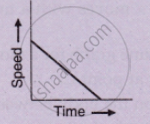Advertisements
Advertisements
प्रश्न
A train starting from rest picks up a speed of 20 ms−1 in 200 s. It continues to move at the same rate for the next 500 s and is then brought to rest in another 100 s.
- Plot a speed-time graph.
- From graph calculate
(a) uniform rate of acceleration
(b) uniform rate of retardation
(c) total distance covered before stopping
(d) average speed.
उत्तर
(i)

(ii)
(a) Uniform rate of acceleration = Slope of v.t. graph from O to A.
= `"AE"/"OE"=20/200` = 0.1 ms−2
(b) Uniform rate of retardation = Slope of v.t. graph from BC
= `"BD"/"CD"=20/100` = 0.2 ms−2
(c) Total distance covered before stopping
= ar(ΔOAE) + ar(ΔABDE) + ar(ΔBCD)
= `1/2xx"OE"xx"AE"+"AE"xx"ED" + 1/2xx"BD"xx"DC"`
= `1/2xx200xx20+20xx500+1/2xx20xx100`
= 2000 + 10000 + 1000
= 13000 m
= 13 km
(d) Average speed = `"Total distance covered"/"Total time taken"=13000/800`
= `130/8`
= 16.25 ms−1
APPEARS IN
संबंधित प्रश्न
What type of motion is represented by the following graph ?

From the displacement-time graph of a cyclist given below in the Figure, find The time after which he reaches the starting point .

Multiple choice Question. Select the correct option.
What does the area of an acceleration – time graph represent?
From the velocity – time graph given below, calculate acceleration in the region AB.

The area under a speed-time graph in a given intervals gives the total distance covered by a body irrespective of its motion being uniform or non-uniform.
How does the slope of a speed-time graph give the acceleration of a body moving along a straight line?
Its time-displacement graph is a straight line.
The slope of the speed–time graph gives ______.
The area under the v-t graph represents a physical quantity that has the unit.
From the v-t graph, ______ can be calculated.
